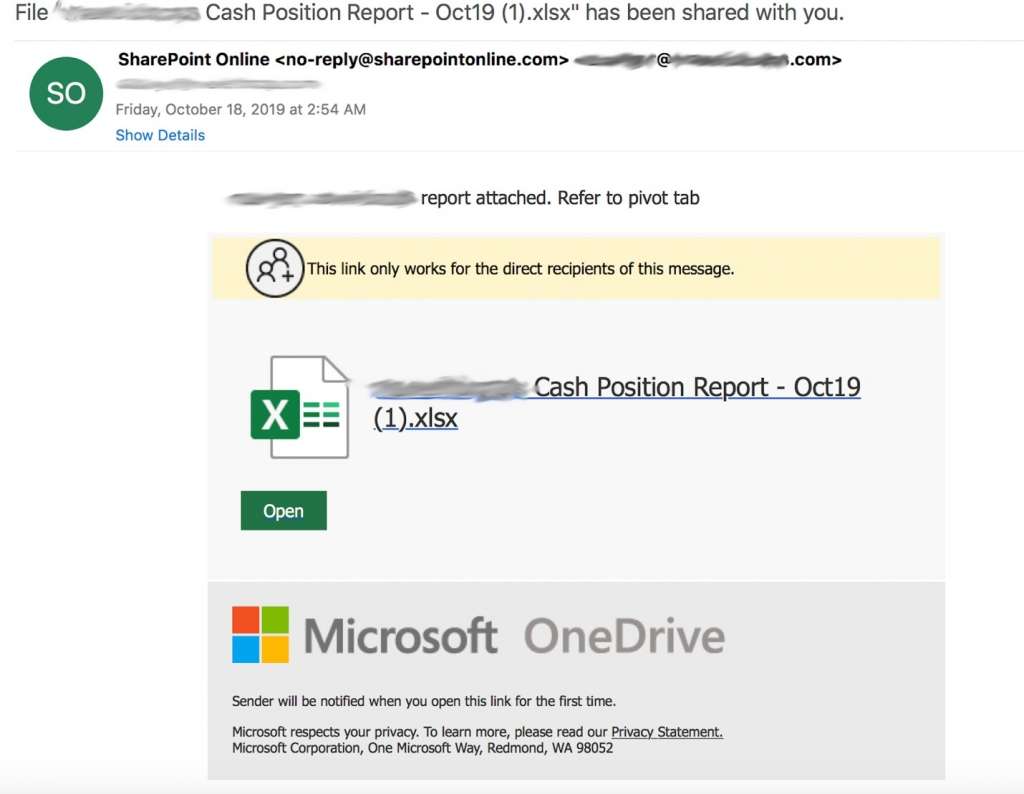Executive Office 365 Accounts Targeted In Multi-Million Dollar Hacking Scheme

Table of Contents
Methods Employed in the Executive Office 365 Hacking Scheme
Cybercriminals employ increasingly sophisticated techniques to breach Executive Office 365 accounts. Understanding these methods is the first step towards effective prevention.
Phishing and Spear Phishing Attacks
Highly targeted phishing emails are a primary vector for these attacks. These aren't your typical spam emails; they are carefully crafted to bypass security measures and exploit human error. Spear phishing attacks, in particular, are personalized to specific individuals within an organization, making them even more convincing.
- Realistic Branding: Attackers meticulously mimic legitimate company branding, using logos and email addresses that closely resemble the real thing.
- Urgent Calls to Action: Emails often create a sense of urgency, pressuring recipients to act quickly without thinking critically.
- Convincing Subject Lines: Subject lines are designed to pique interest and encourage recipients to open the email.
- Embedded Malware: Malicious links or attachments deliver malware that compromises the user's system and grants attackers access to Office 365 accounts. These might be seemingly innocuous documents or links promising important updates or information.
Exploiting Weak Passwords and Credentials
Weak passwords and compromised credentials are significant vulnerabilities. Attackers utilize various methods to gain access:
-
Password Spraying: This involves attempting common password combinations against multiple accounts.
-
Brute-Force Attacks: This technique involves systematically trying every possible password combination until a match is found. This is often automated using specialized software.
-
Multi-Factor Authentication (MFA): Implementing MFA adds a crucial layer of security, requiring multiple forms of authentication (password, code from a mobile app, etc.) to access an account. This significantly hinders unauthorized access.
-
Common Password Mistakes: Using easily guessable passwords, reusing passwords across multiple accounts, and failing to regularly update passwords are common pitfalls.
-
Importance of Password Managers: Secure password managers generate and store strong, unique passwords for each account, eliminating the need to remember complex combinations.
-
MFA Implementation Best Practices: Enforcing MFA across all accounts, using a variety of authentication methods, and educating users on the importance of MFA are essential steps.
Malware and Ransomware Deployment
Once access is gained, malware is often deployed to maintain control and exfiltrate data. Ransomware is frequently used to encrypt data and demand payment for its release.
- Types of Malware Used: Attackers utilize various malware types, including keyloggers (recording keystrokes), Trojans (disguised as legitimate software), and remote access trojans (RATs).
- Ransomware Demands: Victims face exorbitant ransom demands, often in cryptocurrency, to regain access to their encrypted data.
- Data Recovery Challenges: Even after paying the ransom, there's no guarantee of data recovery. The encrypted data may be irrecoverable, resulting in significant data loss.
Impact of the Executive Office 365 Data Breach
The consequences of a successful Executive Office 365 data breach can be far-reaching and devastating.
Financial Losses
Financial losses are substantial and extend beyond the immediate ransom demands:
- Examples of Financial Losses: Direct ransom payments, costs associated with data recovery, IT forensics investigations, and legal fees.
- Lost Productivity: Disruption to business operations caused by data loss and system downtime.
- Cost of Remediation: Expenses involved in restoring systems, implementing enhanced security measures, and notifying affected parties.
Reputational Damage and Loss of Trust
Data breaches severely damage an organization's reputation and erode customer trust:
- Negative Media Coverage: Public disclosure of the breach can result in negative media attention, harming the organization's image.
- Loss of Customer Confidence: Customers may lose confidence and take their business elsewhere.
- Impact on Investor Relations: The breach can negatively impact investor confidence and stock prices.
Legal and Regulatory Consequences
Organizations face significant legal and regulatory repercussions:
- Potential Lawsuits: Legal action from affected customers and partners.
- Regulatory Investigations: Investigations from regulatory bodies (e.g., FTC, GDPR authorities).
- Penalties for Non-Compliance: Substantial fines for violating data protection regulations like GDPR and CCPA.
Protecting Your Executive Office 365 Accounts
Proactive measures are crucial in mitigating the risk of Executive Office 365 account compromises.
Implementing Strong Security Measures
Robust security measures are paramount:
- Enable MFA: Mandate MFA for all accounts.
- Enforce Strong Password Policies: Implement policies requiring complex, unique passwords and regular password changes.
- Regular Software Updates: Keep all software and applications updated with the latest security patches.
- Use of Anti-Malware Software: Deploy robust anti-malware solutions across all devices.
- Employee Security Training: Conduct regular security awareness training to educate employees about phishing and other cyber threats.
Regular Security Audits and Assessments
Regular assessments identify vulnerabilities before attackers can exploit them:
- Frequency of Audits: Conduct regular penetration testing and vulnerability assessments.
- Types of Assessments: Employ various assessment techniques, including network scans, security audits, and simulated phishing attacks.
- Identifying Vulnerabilities: Proactively identify and address security weaknesses in your systems and processes.
Employee Security Awareness Training
Employee education is critical in preventing phishing attacks:
- Regular Training Programs: Implement recurring training programs on phishing recognition and safe email practices.
- Phishing Simulations: Conduct simulated phishing attacks to test employee awareness and identify vulnerabilities.
- Reporting Mechanisms: Establish clear reporting mechanisms for suspicious emails and potential security incidents.
Conclusion
The multi-million dollar hacking scheme targeting Executive Office 365 accounts serves as a stark reminder of the ever-evolving cyber threat landscape. The sophistication of these attacks demonstrates that no organization is immune. By implementing strong security protocols, conducting regular security audits, and providing comprehensive employee training, businesses can significantly reduce their risk of becoming victims of similar attacks. Don't wait until it's too late – prioritize the security of your Executive Office 365 accounts today. Invest in advanced threat protection and ensure your organization is adequately prepared to combat these evolving threats to your Microsoft 365 environment and overall data security. Take control of your cybersecurity posture and protect your business from the devastating consequences of a data breach.

Featured Posts
-
 Corinthians X Sao Bernardo Tudo Sobre O Jogo De Hoje Horario E Onde Assistir
May 05, 2025
Corinthians X Sao Bernardo Tudo Sobre O Jogo De Hoje Horario E Onde Assistir
May 05, 2025 -
 Aritzia Remains Committed To Current Pricing Despite Trump Tariffs
May 05, 2025
Aritzia Remains Committed To Current Pricing Despite Trump Tariffs
May 05, 2025 -
 Kentucky Derby 2025 Meet The Riders Vying For Victory
May 05, 2025
Kentucky Derby 2025 Meet The Riders Vying For Victory
May 05, 2025 -
 Britains Got Talent Teddy Magics Postponed Performance Update
May 05, 2025
Britains Got Talent Teddy Magics Postponed Performance Update
May 05, 2025 -
 Eurovision 2024 Leslies Next Challenge
May 05, 2025
Eurovision 2024 Leslies Next Challenge
May 05, 2025
